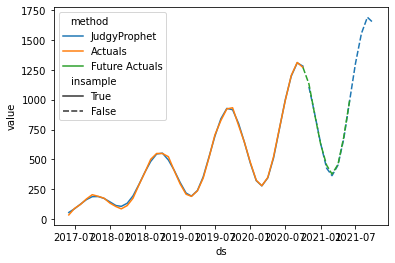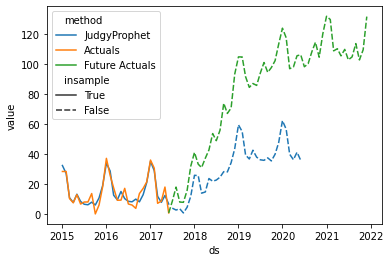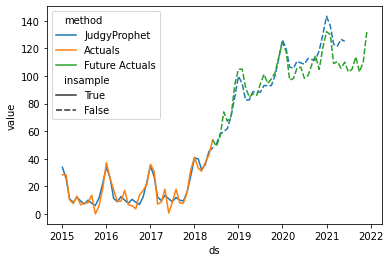Tutorial 3 - Seasonality
Seasonality
Similar to prophet, judgyprophet models seasonality as Fourier series and can handle both additive and multiplicative seasonality. However, the seasonality implementation is currently limited to the index frequency and does not support the split into weekly, monthly, and yearly.
To enable seasonality, simply set the seasonal_period arg to a positive integer (e.g. 12 for monthly data, 7 for daily). The default seasonality is additive, to change this to multiplicative set the arg seasonal_type to be 'mult'. The Fourier order is set via the fourier_order parameter, with the default value set to seasonal_period - 1. The Fourier order determines how quickly the seasonality can change and the reducing order compared to the default parameters might help to avoid overfitting.
Additive Seasonality
In the case of additive seasonality, the amplitude of the seasonal variation is independent of the trend and is hence roughly constant over the time series. If additive seasonality is selected, judgyprophet will rescale the time series onto zero mean and standard variance. An example is shown here:
from judgyprophet import JudgyProphet
import pandas as pd
import seaborn as sns
from judgyprophet.tutorials.resources import get_additive_seasonality_linear_trend
example_data = get_additive_seasonality_linear_trend()
# Cutoff the data to October 2020
cutoff = "2020-10-01"
data_cutoff = example_data.loc[:cutoff]
jp = JudgyProphet()
# We are passing in a simple time series without trend or level events. The seasonality is set to 12
# and the seasonality component is simply additive.
jp.fit(
data=data_cutoff,
level_events=[],
trend_events=[],
seasonal_period=12,
seasonal_type="add",
# Set random seed for reproducibility
seed=13
)
predictions = jp.predict(horizon=int(12))
# Plot the data:
predict_df = (
predictions.reset_index()
.rename(columns={'index': 'ds', 'forecast': 'value'})
.assign(method="JudgyProphet")
.loc[:, ["ds", "value", "insample", "method"]]
)
actuals_df = (
data_cutoff.reset_index()
.rename(columns={'index': 'ds', 0: 'value'})
.assign(method="Actuals", insample=True)
)
future_actuals_df = (
example_data.loc[cutoff:]
.reset_index()
.rename(columns={'index': 'ds', 0: 'value'})
.assign(method="Future Actuals", insample=False)
)
plot_df = (
pd.concat([predict_df, actuals_df, future_actuals_df])
.reset_index(drop=True)
)
sns.lineplot(data=plot_df, x='ds', y='value', hue='method', style='insample', style_order=[True, False])
INFO:judgyprophet.judgyprophet:Rescaling onto 0-mean, 1-sd.
WARNING:judgyprophet.utils:No active trend or level events (i.e. no event indexes overlap with data). The model will just fit a base trend to the data.
Initial log joint probability = -891.479
Iter log prob ||dx|| ||grad|| alpha alpha0 # evals Notes
19 -1.34039 1.12595e-05 0.00168501 0.5461 0.5461 30
Iter log prob ||dx|| ||grad|| alpha alpha0 # evals Notes
21 -1.34039 1.01095e-06 0.00067455 0.1367 0.9362 33
Optimization terminated normally:
Convergence detected: relative gradient magnitude is below tolerance
<AxesSubplot:xlabel='ds', ylabel='value'>

Multiplicative Seasonality
In case of multiplicative seasonality, the seasonal variations are changing proportional to the level of the series. If multiplicative seasonality is selected, judgyprophet will rescale the time series by shifting all values positive with standard variance. An example is shown here:
from judgyprophet import JudgyProphet
import pandas as pd
import seaborn as sns
from judgyprophet.tutorials.resources import get_multiplicative_seasonality_linear_trend
example_data = get_multiplicative_seasonality_linear_trend()
# Cutoff the data to October 2020
cutoff = "2020-10-01"
data_cutoff = example_data.loc[:cutoff]
jp = JudgyProphet()
# The multiplicative example time series has a constant trend component, but the seasonality
# is multiplicative and has a large amplitude. Again the period is set to 12.
jp.fit(
data=data_cutoff,
level_events=[],
trend_events=[],
seasonal_period=12,
seasonal_type="mult",
# Set random seed for reproducibility
seed=13
)
predictions = jp.predict(horizon=int(12))
# Plot the data:
predict_df = (
predictions.reset_index()
.rename(columns={'index': 'ds', 'forecast': 'value'})
.assign(method="JudgyProphet")
.loc[:, ["ds", "value", "insample", "method"]]
)
actuals_df = (
data_cutoff.reset_index()
.rename(columns={'index': 'ds', 0: 'value'})
.assign(method="Actuals", insample=True)
)
future_actuals_df = (
example_data.loc[cutoff:]
.reset_index()
.rename(columns={'index': 'ds', 0: 'value'})
.assign(method="Future Actuals", insample=False)
)
plot_df = (
pd.concat([predict_df, actuals_df, future_actuals_df])
.reset_index(drop=True)
)
sns.lineplot(data=plot_df, x='ds', y='value', hue='method', style='insample', style_order=[True, False])
INFO:judgyprophet.judgyprophet:Rescaling by shifting all values positive with 1-sd.
WARNING:judgyprophet.utils:No active trend or level events (i.e. no event indexes overlap with data). The model will just fit a base trend to the data.
Initial log joint probability = -775.468
Iter log prob ||dx|| ||grad|| alpha alpha0 # evals Notes
19 -105.965 0.0490619 1203.53 0.04941 1 32
Iter log prob ||dx|| ||grad|| alpha alpha0 # evals Notes
39 -12.2029 0.0634662 440.207 0.1485 0.1485 64
Iter log prob ||dx|| ||grad|| alpha alpha0 # evals Notes
59 -0.683534 0.0372809 68.3501 1 1 84
Iter log prob ||dx|| ||grad|| alpha alpha0 # evals Notes
79 -0.454028 0.00336031 7.70556 0.8053 0.8053 109
Iter log prob ||dx|| ||grad|| alpha alpha0 # evals Notes
99 -0.442297 0.000894112 6.38619 0.006837 1 134
Iter log prob ||dx|| ||grad|| alpha alpha0 # evals Notes
119 -0.402061 0.0581892 7.15489 0.5184 1 159
Iter log prob ||dx|| ||grad|| alpha alpha0 # evals Notes
139 -0.287525 0.0223029 0.741186 1 1 187
Iter log prob ||dx|| ||grad|| alpha alpha0 # evals Notes
159 -0.285187 0.000493407 1.35585 0.3357 1 213
Iter log prob ||dx|| ||grad|| alpha alpha0 # evals Notes
179 -0.285081 5.78588e-05 0.106578 0.2866 0.02866 238
Iter log prob ||dx|| ||grad|| alpha alpha0 # evals Notes
199 -0.28508 6.70665e-06 0.00713309 0.1648 0.1648 259
Iter log prob ||dx|| ||grad|| alpha alpha0 # evals Notes
206 -0.28508 1.07542e-05 0.00613299 1 1 267
Optimization terminated normally:
Convergence detected: relative gradient magnitude is below tolerance
<AxesSubplot:xlabel='ds', ylabel='value'>

Combining Seasonality with Events
Both seasonality can be combined with trend events, damping, level events, and unspecified changepoints. We will now walk through an example time series which contains a damped trend event and shows additive seasonality. Let's look at the data:
from judgyprophet.tutorials.resources import get_additive_seasonal_damped_trend_event
example_data = get_additive_seasonal_damped_trend_event()
example_data.plot.line()
<AxesSubplot:>

We can see from the plot that there is an uptick in trend around January 2018. The uptick in trend is quite steep until the end of 2019 where we observe stronger damping. We also see that the time series has a seasonal pattern, with a seasonal_period of 12 and a peak in December each year.
Forecasting with JudgyProphet before the event occurs
The estimate of the trend event is a trend increase of 6 with a damping parameter of 0.9.
from judgyprophet import JudgyProphet
import pandas as pd
import seaborn as sns
trend_events = [
{'name': "New saturating market entry", 'index': '2018-01-01', 'm0': 6, 'gamma': .9}
]
# Cutoff the data to June 2017
cutoff = "2017-06-01"
data_cutoff = example_data.loc[:cutoff]
jp = JudgyProphet()
# We have one trend event and no level events. The seasonality is additive again.
jp.fit(
data=data_cutoff,
sigma_trend=0.1,
level_events=[],
unspecified_changepoints=10,
sigma_unspecified_changepoints=.2,
trend_events=trend_events,
seasonal_period=12,
seasonal_type="add",
# Set random seed for reproducibility
seed=13
)
predictions = jp.predict(horizon=int(36))
# Plot the data:
predict_df = (
predictions.reset_index()
.rename(columns={'index': 'ds', 'forecast': 'value'})
.assign(method="JudgyProphet")
.loc[:, ["ds", "value", "insample", "method"]]
)
actuals_df = (
data_cutoff.reset_index()
.rename(columns={'index': 'ds', 0: 'value'})
.assign(method="Actuals", insample=True)
)
future_actuals_df = (
example_data.loc[cutoff:]
.reset_index()
.rename(columns={'index': 'ds', 0: 'value'})
.assign(method="Future Actuals", insample=False)
)
plot_df = (
pd.concat([predict_df, actuals_df, future_actuals_df])
.reset_index(drop=True)
)
sns.lineplot(data=plot_df, x='ds', y='value', hue='method', style='insample', style_order=[True, False])
INFO:judgyprophet.judgyprophet:Rescaling onto 0-mean, 1-sd.
WARNING:judgyprophet.judgyprophet:Post-event data for trend event New saturating market entry less than 0 points. Event deactivated in model. Event index: 2018-01-01, training data end index: 2015-01-01 00:00:00
WARNING:judgyprophet.utils:No active trend or level events (i.e. no event indexes overlap with data). The model will just fit a base trend to the data.
Initial log joint probability = -5618.69
Iter log prob ||dx|| ||grad|| alpha alpha0 # evals Notes
19 -19.5311 0.107624 53.5313 1 1 25
Iter log prob ||dx|| ||grad|| alpha alpha0 # evals Notes
39 -14.4873 0.00450173 32.1225 1 1 54
Iter log prob ||dx|| ||grad|| alpha alpha0 # evals Notes
59 -11.3416 0.0164259 63.5553 0.1261 1 83
Iter log prob ||dx|| ||grad|| alpha alpha0 # evals Notes
79 -10.031 0.00192964 42.0027 0.4045 0.4045 111
Iter log prob ||dx|| ||grad|| alpha alpha0 # evals Notes
99 -9.91568 0.00123052 20.6714 0.3407 1 136
Iter log prob ||dx|| ||grad|| alpha alpha0 # evals Notes
119 -9.74583 0.0178502 45.6554 1 1 161
Iter log prob ||dx|| ||grad|| alpha alpha0 # evals Notes
139 -9.58822 0.00240934 24.5607 0.1831 1 185
Iter log prob ||dx|| ||grad|| alpha alpha0 # evals Notes
159 -9.55939 0.000174537 18.265 1 1 214
Iter log prob ||dx|| ||grad|| alpha alpha0 # evals Notes
179 -9.55721 4.74996e-06 18.6232 1 1 243
Iter log prob ||dx|| ||grad|| alpha alpha0 # evals Notes
199 -9.55707 1.07478e-05 21.7289 1 1 267
Iter log prob ||dx|| ||grad|| alpha alpha0 # evals Notes
219 -9.5541 1.0315e-05 21.3723 1 1 288
Iter log prob ||dx|| ||grad|| alpha alpha0 # evals Notes
239 -9.50413 0.00075237 20.6816 0.6394 0.6394 309
Iter log prob ||dx|| ||grad|| alpha alpha0 # evals Notes
259 -9.41589 0.000411908 21.7004 1 1 331
Iter log prob ||dx|| ||grad|| alpha alpha0 # evals Notes
279 -9.39884 1.20103e-05 20.8879 0.3439 0.3439 355
Iter log prob ||dx|| ||grad|| alpha alpha0 # evals Notes
299 -9.39799 4.26641e-06 20.0502 0.476 0.476 379
Iter log prob ||dx|| ||grad|| alpha alpha0 # evals Notes
319 -9.37685 5.71275e-05 19.885 0.3824 0.3824 405
Iter log prob ||dx|| ||grad|| alpha alpha0 # evals Notes
339 -9.34918 0.000126588 18.6708 0.9182 0.9182 429
Iter log prob ||dx|| ||grad|| alpha alpha0 # evals Notes
359 -9.34728 1.3233e-05 20.7019 1 1 455
Iter log prob ||dx|| ||grad|| alpha alpha0 # evals Notes
379 -9.33447 2.78134e-05 20.1768 0.5231 0.5231 477
Iter log prob ||dx|| ||grad|| alpha alpha0 # evals Notes
399 -9.33284 2.29302e-06 20.0762 0.6157 0.6157 501
Iter log prob ||dx|| ||grad|| alpha alpha0 # evals Notes
419 -9.33248 1.2898e-05 19.1065 0.08486 1 529
Iter log prob ||dx|| ||grad|| alpha alpha0 # evals Notes
420 -9.33247 3.42574e-06 21.2674 1.793e-07 0.001 576 LS failed, Hessian reset
439 -9.33237 2.57199e-07 22.0328 0.3448 1 603
Iter log prob ||dx|| ||grad|| alpha alpha0 # evals Notes
450 -9.33237 7.89272e-09 20.4987 0.2986 1 621
Optimization terminated normally:
Convergence detected: absolute parameter change was below tolerance
<AxesSubplot:xlabel='ds', ylabel='value'>

Forecasting with JudgyProphet after the event occurs
We can see that the model picks up correctly the seasonal pattern and incorporates the trend event. After a few more data points are observed, the model learned that the initial trend event estimates were poorly and corrects its forecast accordingly. Let's look at the forecast repeated in June 2018:
from judgyprophet import JudgyProphet
import pandas as pd
import seaborn as sns
trend_events = [
{'name': "New saturating market entry", 'index': '2018-01-01', 'm0': 6, 'gamma': .9}
]
# Cutoff the data to June 2017
cutoff = "2018-06-01"
data_cutoff = example_data.loc[:cutoff]
jp = JudgyProphet()
# We have one trend event and no level events. The seasonality is additive again.
jp.fit(
data=data_cutoff,
sigma_trend=0.1,
level_events=[],
unspecified_changepoints=10,
sigma_unspecified_changepoints=.2,
trend_events=trend_events,
seasonal_period=12,
seasonal_type="add",
# Set random seed for reproducibility
seed=13
)
predictions = jp.predict(horizon=int(36))
# Plot the data:
predict_df = (
predictions.reset_index()
.rename(columns={'index': 'ds', 'forecast': 'value'})
.assign(method="JudgyProphet")
.loc[:, ["ds", "value", "insample", "method"]]
)
actuals_df = (
data_cutoff.reset_index()
.rename(columns={'index': 'ds', 0: 'value'})
.assign(method="Actuals", insample=True)
)
future_actuals_df = (
example_data.loc[cutoff:]
.reset_index()
.rename(columns={'index': 'ds', 0: 'value'})
.assign(method="Future Actuals", insample=False)
)
plot_df = (
pd.concat([predict_df, actuals_df, future_actuals_df])
.reset_index(drop=True)
)
sns.lineplot(data=plot_df, x='ds', y='value', hue='method', style='insample', style_order=[True, False])
INFO:judgyprophet.judgyprophet:Rescaling onto 0-mean, 1-sd.
INFO:judgyprophet.judgyprophet:Adding trend event New saturating market entry to model. Event index: 2018-01-01, training data start index: 2015-01-01 00:00:00, training data end index: 2018-06-01 00:00:00. Initial gradient: 6. Damping: 0.9.
WARNING:judgyprophet.utils:Unspecified changepoint with index 2018-01-01 00:00:00 also specified as a level or trend event. Removing this changepoint.
Initial log joint probability = -4219.81
Iter log prob ||dx|| ||grad|| alpha alpha0 # evals Notes
19 -45.4011 0.0443425 326.047 1 1 26
Iter log prob ||dx|| ||grad|| alpha alpha0 # evals Notes
39 -15.3423 0.00201394 41.5814 1 1 53
Iter log prob ||dx|| ||grad|| alpha alpha0 # evals Notes
59 -11.4289 0.0222713 70.3068 1 1 82
Iter log prob ||dx|| ||grad|| alpha alpha0 # evals Notes
79 -9.74468 0.0019911 38.3992 0.8659 0.8659 110
Iter log prob ||dx|| ||grad|| alpha alpha0 # evals Notes
99 -9.55453 0.00466659 25.2859 0.949 0.949 137
Iter log prob ||dx|| ||grad|| alpha alpha0 # evals Notes
119 -9.42124 0.000328639 21.1329 0.3671 1 163
Iter log prob ||dx|| ||grad|| alpha alpha0 # evals Notes
139 -9.38936 0.00514148 27.2595 1 1 196
Iter log prob ||dx|| ||grad|| alpha alpha0 # evals Notes
159 -9.3399 0.00760439 37.8239 1 1 223
Iter log prob ||dx|| ||grad|| alpha alpha0 # evals Notes
179 -9.27552 0.000532321 24.6411 0.4927 0.4927 247
Iter log prob ||dx|| ||grad|| alpha alpha0 # evals Notes
199 -9.23377 0.00261612 16.9745 0.8399 0.8399 269
Iter log prob ||dx|| ||grad|| alpha alpha0 # evals Notes
202 -9.23013 0.000104263 18.2691 5.753e-06 0.001 364 LS failed, Hessian reset
219 -9.19983 0.00127842 29.8317 1 1 381
Iter log prob ||dx|| ||grad|| alpha alpha0 # evals Notes
239 -9.16268 0.00026094 21.9496 3.298 0.3298 403
Iter log prob ||dx|| ||grad|| alpha alpha0 # evals Notes
259 -9.1381 0.00160896 29.4252 0.9121 0.9121 426
Iter log prob ||dx|| ||grad|| alpha alpha0 # evals Notes
279 -9.11448 0.000430079 17.2828 1 1 451
Iter log prob ||dx|| ||grad|| alpha alpha0 # evals Notes
299 -9.09913 0.000132984 15.3301 0.2225 0.2225 479
Iter log prob ||dx|| ||grad|| alpha alpha0 # evals Notes
319 -9.09577 7.96264e-05 20.5328 0.9646 0.9646 507
Iter log prob ||dx|| ||grad|| alpha alpha0 # evals Notes
339 -9.0927 5.35475e-06 18.2672 0.38 1 533
Iter log prob ||dx|| ||grad|| alpha alpha0 # evals Notes
359 -9.09266 1.83214e-08 16.0514 1 1 567
Iter log prob ||dx|| ||grad|| alpha alpha0 # evals Notes
365 -9.09266 6.04342e-09 18.2719 0.6683 0.6683 573
Optimization terminated normally:
Convergence detected: absolute parameter change was below tolerance
/Users/kpxh622/github/judgyprophet/judgyprophet/utils.py:31: UserWarning: Unspecified changepoint with index 2018-01-01 00:00:00 also specified as a level or trend event. Removing this changepoint.
warnings.warn(msg)
<AxesSubplot:xlabel='ds', ylabel='value'>
